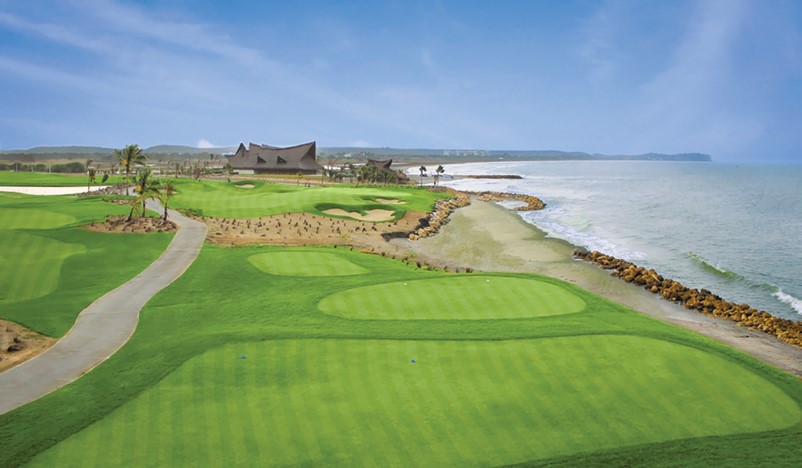
Thrust upon the global stage in 2016 with golf’s return to the Olympic Games for the first time since 1904, the continent of South America continues to evidence a degree of continuing education across the game’s international fairways.
Yet, swing by swing, a host of Latin American nations are undoubtedly on the move up the game’s worldly food chain.
In Colombia, a coalescence of modern golf interest began – like much of the globe – with Tiger Woods’ rise to domination. The success of Medellin-born Camillo Villegas saw Colombians’ passion ensue, before the debut of PGA Tour Latinoamerica in 2012 – coupled with a host of Web.com Tour events held across South America – found the nation further embracing the Gentleman’s Game.
Akin to, say, much of Mexico, golf is still a sport for the affluent in Colombia, and the proletariat remain more closely connected to soccer and baseball.
But as Colombia works aggressively to move away from its dated reputation as the nation of Narcos, a stated increase in infrastructure and tourism has paved a graduating interest, education and participation across the country’s fairways.
Debuted in 2012, Colombia’s TPC Cartagena at Karibana from Nicklaus Design is the only South American track in the well-reputed TPC network. A lush, lake-heavy and well-forested play across its front side, the grounds’ latter nine presents the more alluring aesthetic of several beachfront holes.
Host to Web.com events in 2015 and 2016, the course enjoyed the completion of the on-site Conrad Cartagena resort at the close of 2017.
And though the forested grounds along the Caribbean Sea play with championship flair, the learning curve comes with its costs – via both capital and culture.
“The biggest challenge for us is that, here, golf is not yet as popular as it is in the United States,” says Juan Felipe Raigoza, director of golf and head professional at TPC Cartagena at Karibana. “Golf here is played at mostly private clubs; it makes access tough for everybody, and is still considered expensive for those who are club members.”
For course operators, the expenses see pesos escape the purse for just about everything golf-related.
“It’s expensive for us to have to import everything from the U.S.,” Raigoza adds. “It’s tough. It’s everything: clubs, balls, hats, shirts – anything golf-related, we get from the U.S. And even for companies that have distributors down here, we still spend more. Let’s say a driver costs $500. Getting it down here still involves tax – and our tax is 19 percent – plus there are duties.”
And for on-course equipment?
“Same goes for machinery – there’s a big tax on it,” Raigoza says. “Maybe upwards of paying 60 percent more when all is said and done.”
While Colombian golf costs are mitigated via manpower, such savings have their own leveling of the pay scales.
“Here, most of our staff has learned about golf from scratch,” Raigoza says. “The labor in the U.S. is probably more qualified labor. You’ve got a lot of courses, a lot of golf exposure and to golf courses and golf course maintenance. You can study course maintenance there. Down here, the labor is way, way cheaper, but it’s not as qualified as you’ll get in the U.S. We have about 50 courses in our country, so that’s not too much for a labor force to draw employees who are very familiar with the game.”
Sporting tee-to-green paspalum (save for spots of zoysiagrass around its myriad lakes) conditions are seasonally reliant on nature’s hand. “Being near the ocean, of course, salt is always a problem, so we rely on rainwater to wash things out,” Raigoza says. “It makes maintenance tough during our dry season” — typically from January to March.
Proximity to the equator and its seaside setting make for additional challenges for staff, grass and TPC guest expectations alike. “Environmentally, the heat here, the humidity, also makes it a tough job to work outside,” Raigoza adds.
Working indoors requires additional education to be on par with resort guest and golf experience.
“When the hotel opened, Juan came over twice to provide the staff a few classes about the terms, the play and how golfers talk,” says Jairo Cuesta, marketing and communications manager at Conrad Cartagena. “It’s been very useful for us, from the servers to the marketing department to be able to better relate to our guests.”
For native Cartagenans like Cuesta, the city’s burgeoning golf and resort business proves a welcome addition to the economy of opportunity.
“In Cartagena, the addition of the hotel to the course has seen this all grow up,” Cuesta says. “The golf and hotel business in Colombia is a great job for many people, as it gives employees an opportunity to grow professionally and the companies provide a great deal for us and our families.”
With such opportunity comes the responsibility to understand both the language and lexicon of golf guests. It’s a fresh lesson being learned across all rungs of the resort ladder, from the top on down.
“For sure there have been some challenges to learn about golf at a high level, but on the other side of that – they’re learning fast,” Conrad Cartagena general manager Stephane Mercier says. “Their hearts are in the right place, and there’s a lot of pride and motivation involved working at this golf course.”
Adding to its golf culture, Cartagena will soon welcome the addition of another high-end course for visitors, with Greg Norman’s Mar de Indias GC currently in construction. Sharks aside, dispelling the notion that Colombia makes for an unsafe visit is a cloud that the nation is working to escape, by-and-by.
Domestically, visitors from the U.S. will note no mention of Cartagena concerns via the State Department, while the on-site guests will both see and feel an overt blanket of security. From a continual police presence in Cartagena’s famed “Walled City” to seeing private security discreetly perched on the occasional TPC fairways or tee box, ample guests from the U.S. (along with Canada and Europe) are enjoying the experience with enhanced regularity.
“I think for the Americans coming down here, more and more, it’s a very affordable trip,” says Medellin-based Carlos De La Ossa, an avid golfer and Colombian sportscaster-turned-marketer. “And, for tourists, we have a lot better infrastructure in Colombia to attract tourists. When I was a kid, 20 years ago, I don’t really remember Americans coming here at all.”

Explore the September 2019 Issue
Check out more from this issue and find your next story to read.
Latest from Golf Course Industry
- Audubon International announces newest leadership appointees
- Southern golf trifecta
- Sports for Nature Framework gains new signatories
- Camiral Golf & Wellness upgrades Stadium Course
- Troon selected to manage The University Club of Milwaukee
- Kafka Granite adds new business development manager
- GCSAA celebrates 10-year anniversary of collaboration with Congress
- DLF launches new seed enhancement solution





